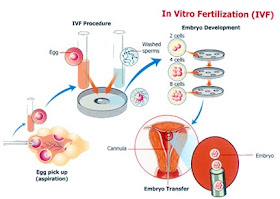 Assisted reproduction is a solution to the problem of inbreeding.
Assisted reproduction is a solution to the problem of inbreeding.Assisted reproduction
 Sperm bank - freezing collected semen
Sperm bank - freezing collected semenSperm samples are collected from males, checked for sperm activity and then diluted with a medium containing a buffer solution and albumen. Small volumes of semen are put into straws (thin tubes) and are stored in liquid nitrogen at -196 degrees Celcius.
Artificial insemination (IA)
- a straw is placed into warm water to activate sperm
- the straw is placed into a catheter --> inserted into the vagina, through the cervis, into the uterus
- resulting embryos are 'flushed out' of the uterus
- embryo transfer: embryo gets transferred to other females (surrogate mothers) that had had hormonal treatment to prepare for pregnancy
- protects endangered animals from pregnancy
- the endangered female becomes the source of many offspring
In-vitro fertilisation (IVF)
- oocyte collected by inserting needle into ovaries --> withdraw mature follicles
- oocyte cultured in a medium --> mixed with semen
- resulting zygotes divide --> form embryos --> cultured for several days
- embryo is placed into the mother or into several females of same or different species
Problems of successful conservation
- organism is saved from extinction has increased in numbers beyond the capacity of the ecosystem to sustain such numbers.
- culling: aim - to reduce numbers
- transferring animals to places with small populations
- birth control: chemical contraceptives: vaccine that targets the region surrounding layer of glycoprotein around egg (vaccine produces immune response --> produce antibodies against glycoproteins)
- antibodies attach to glycoprotein and block sperms from fertilising egg
- 90% success rate
18.3 Conservation Maintaining biodiversity is important for many reasons. Actions to maintain biodiversity must be taken at local, national and global levels. It is important to conserve ecosystems as well as individual species. a) discuss the threats to the biodiversity of aquatic and terrestrial ecosystems (see 18.1b) b) discuss the reasons for the need to maintain biodiversity c) discuss methods of protecting endangered species, including the roles of zoos, botanic gardens, conserved areas (national parks and marine parks), ‘frozen zoos’ and seed banks d) discuss methods of assisted reproduction, including IVF, embryo transfer and surrogacy, used in the conservation of endangered mammals e) discuss the use of culling and contraceptive methods to prevent overpopulation of protected and non-protected species f) use examples to explain the reasons for controlling alien species g) discuss the roles of non-governmental organisations, such as the World Wide Fund for Nature (WWF) and the Convention on International Trade in Endangered Species of Wild Fauna and Flora (CITES), in local and global conservation h) outline how degraded habitats may be restored with reference to local or regional examples |


No comments:
Post a Comment